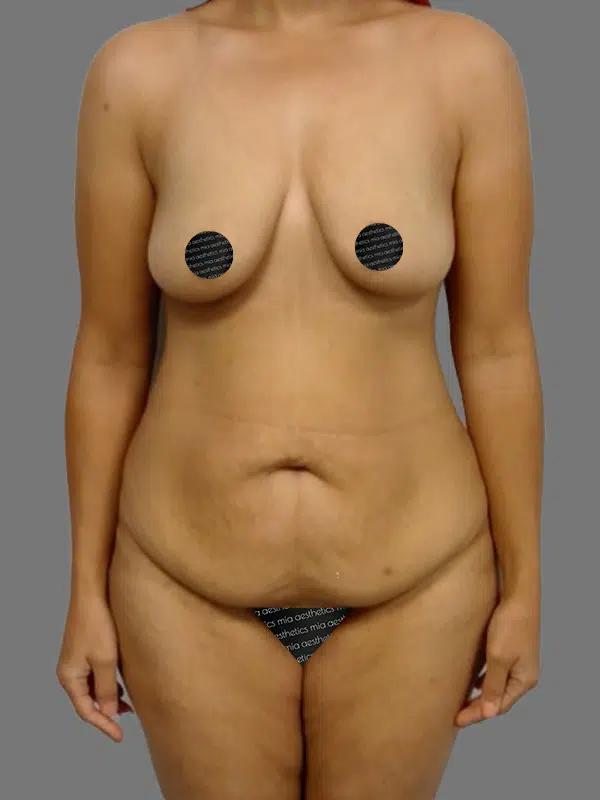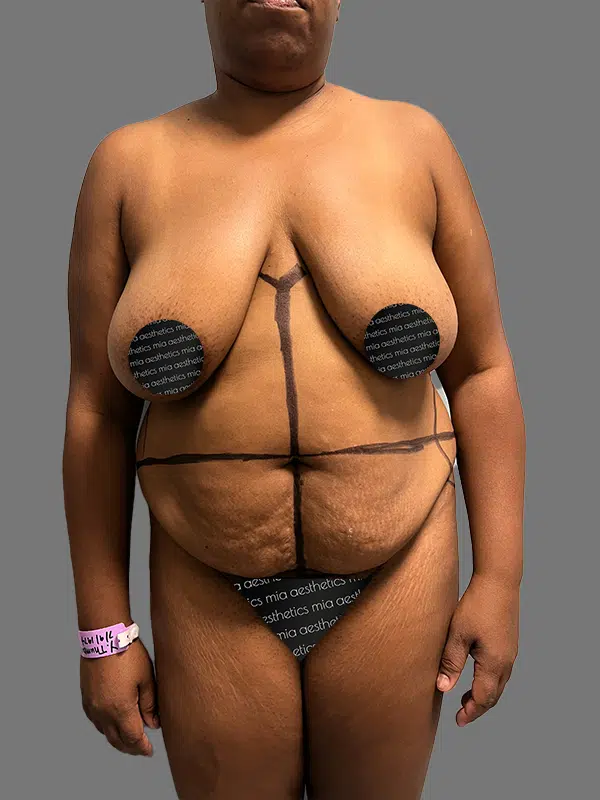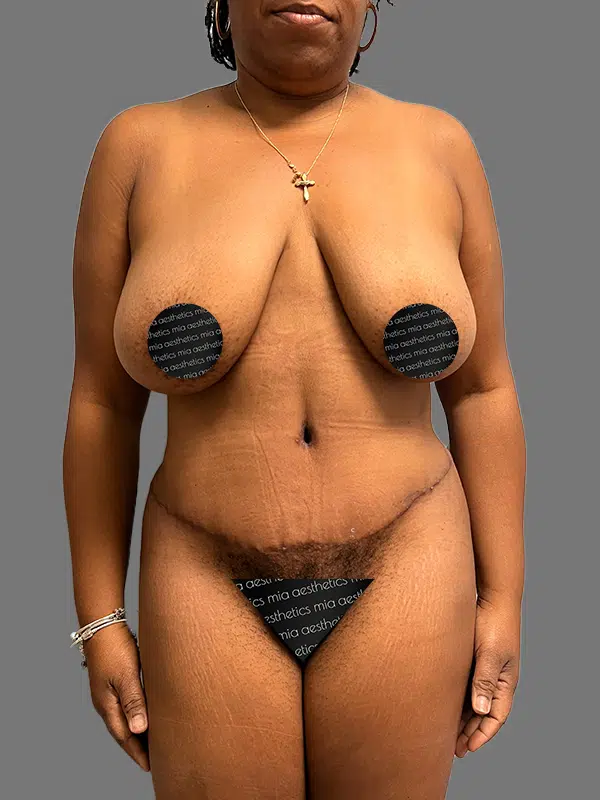Home / Conditions / Apron Belly
Sometimes called a mother’s apron and technically known as a pannus stomach, an apron belly is a stomach that hangs in front of you. A lot of people carry some extra fat in their abdomens, but that’s not quite the same as an apron belly. We’re not talking about your average beer belly here. In the case of an apron belly, extra fat and skin (mostly skin) on the stomach actually sag, hanging down in front of your body.
In mild cases, an apron belly may simply hang below your belly button or fall over the waistband of your pants. In more extreme cases, the apron of skin and fat may hang in front of your thighs or reach down almost to the knees. Doctors diagnose an apron belly when the stomach hangs down far enough to reach the pubic hairline.
There are many factors that can cause an apron belly. One is obesity. When we gain weight, we don’t get to decide where it goes. Although rare, sometimes this extra fat deposits itself into the stomach in such a way that a pannus forms. It’s more likely that you will develop a pooch on your lower abdomen or a bit of overall stomach flab, but the formation of a pannus is a possibility.
Just as weight gain can cause an apron belly, so can weight loss. If you lose a large amount of weight, your skin likely won’t be able to tighten back to its original position. The result is often a large apron of extra skin that hangs from your stomach. Unfortunately, no amount of dieting or exercising will correct this problem. It’s simply a manifestation of the fact that the skin has been stretched too far for too long, and surgically removing it is the only option.
Pregnancy too can cause an apron belly. Although it is a beautiful time, pregnancy can leave behind some unwanted changes to your body, and an apron belly is one of them. This is why the condition is sometimes referred to as a mother’s apron.
During pregnancy, your abdominal muscles stretch and sometimes tear apart from each other. This tear creates a vertical split between them that can’t always heal itself, thus allowing the stomach to sag and hang in ways that it didn’t before pregnancy. Even if your muscles managed to stay intact during your pregnancy, they will be separated during a c-section if you need one. This can cause a pooch in some women or a more pronounced apron belly in others.
If truth in advertising laws applied to menopause, the tagline would probably read, “Menopause: Come for the hot flashes, stay for the belly fat.” During the hormonal changes of menopause, fat from your thighs and hips may migrate to your belly. You may also gain weight, and most women complain that all of this extra lands squarely in the belly. As is true of pregnancy, this can lead to a pooch in some women or a full-blown apron belly in others.
As in many health conditions, age and genetics also play a role. As people age, their skin naturally loses elasticity due to decreased production of collagen and elastin fibers. The gravitational pull on weakened and less elastic skin can lead to sagging, particularly in the abdominal area. Genetic factors can determine skin elasticity and fat distribution in the body. Some individuals may be genetically predisposed to develop more significant abdominal fat and weaker skin elasticity, making them more likely to develop a pannus stomach.
Obesity and rapid weight loss can both cause an apron belly, putting individuals whose weight often fluctuates at a higher risk for developing the condition. Each stretching of the skin degrades it a bit further, making every subsequent weight loss more likely to be the one the skin doesn’t retract for. Losing large amounts of weight very quickly, such as occurs after gastric bypass surgery, also significantly increases the risk of apron belly.
As previously mentioned, pregnancy can stretch the skin and abdominal muscles. Multiple pregnancies increase the likelihood of developing an apron belly, especially if the pregnancies are close together or involve large babies or multiples.
Unfortunately, age is also a risk factor. Reduced collagen and elastin production means the skin loses elasticity with age, and this can make the skin less able to retract after being stretched. You can also lose muscle tone as you age, and weak abdominal walls can contribute to a pannus stomach. Genetic factors, too, can determine skin elasticity, fat distribution, and overall body shape, influencing the likelihood of developing an apron belly.
Lifestyle factors can also weaken the abdominal wall as well as age. Physical inactivity can lead to muscle weakness, particularly in the abdominal area, and contribute to the accumulation of fat.
Certain medical conditions, such as hypothyroidism, polycystic ovary syndrome (PCOS), Cushing’s syndrome, and diabetes, can make it difficult to maintain a healthy weight and may predispose individuals to weight gain, particularly in the abdominal area. These illnesses can contribute to an increase in belly fat and ultimately lead to an apron belly.
Although you may not like the way an apron belly looks, the reasons to treat it go beyond cosmetics. An apron belly can cause a myriad of health concerns, and some of them are quite serious.
One of the problems people with an apron belly most often encounter is back pain. The extra weight of an apron belly can pull the center of gravity forward, placing stress on the back and causing lower back pain. To compensate for the extra weight, people sometimes adopt poor posture, which can exacerbate back issues and lead to long-term musculoskeletal problems.
The weight of the apron belly can also increase intra-abdominal pressure, leading to or exacerbating ventral hernias, where abdominal tissue or part of the intestine bulges through a weak spot in the abdominal wall.
Rashes are also common in the skin folds beneath an apron belly due to the warm, moist environment. These rashes are often fungal, bacterial, or yeast infections, and they cause discomfort, redness, and odor. Constant friction due to the skin folds rubbing together can cause skin breakdown, ulceration, and even serious infections if not properly managed.
The size of the apron belly and the discomfort of associated rashes can physically restrict movement, making it difficult to perform daily activities, exercise, and maintain hygiene. This restriction can lead to a sedentary lifestyle, contributing to further weight gain and health decline.
Excess body fat, especially around the abdomen, is associated with an increased risk of developing several serious chronic health conditions. These include:
People struggling with an apron belly often resort to surgery because it’s the only real option they have. Although nothing is impossible, it’s highly unlikely that exercise and dietary changes will eliminate apron belly. Most apron bellies are comprised mostly of loose skin, and no amount of diet or exercise can restore the elasticity of permanently stretched skin.
Further complicating the issue is the fact that when fat is present, it’s abdominal fat. This fat can be stubbornly resistant to diet and exercise, especially when hormonal factors also play a role. You simply can’t exercise away your hormones.
And once again we see age come into play. As people age, their metabolism naturally slows down, which can reduce the rate at which their bodies burn calories and fat. This change makes it harder to lose fat accumulated in the apron belly through diet and exercise alone.
There are two surgeries your doctor may recommend for an apron belly. The one people are most familiar with is the tummy tuck. During a tummy tuck, the surgeon makes an incision as low on the abdomen as possible. They next examine and repair the muscles of the abdominal wall, correcting any tears, weaknesses, or defects. Doing so corrects damage caused by a pregnancy, c-section, or other injuries. Excess fat and skin are then removed, and the remaining skin is stretched tight over the abdomen and the incision is closed.
Your surgeon may instead recommend a panniculectomy. A panniculectomy is a surgical procedure designed only to remove the excess fat and skin that comprise an apron belly. The finished results will look like a tummy tuck, but the surgeon doesn’t repair the abdominal wall during this procedure. This surgery is a good choice if your apron belly is the result of hormonal changes or excessive weight loss and not damage to your abdominal wall.
The tummy tuck is a slightly more involved procedure due to the addition of the abdominal wall repair, but recovery from the two surgeries is similar. Most patients return to work two to four weeks after a panniculectomy and two to three weeks after a tummy tuck. Lifting and other restrictions are usually removed four to six weeks after a panniculectomy and six to eight weeks after a tummy tuck.
Both surgeries can greatly improve movement and comfort, eliminating the rashes, back pain, and other problems caused by an apron belly. You should ask a qualified plastic surgeon which procedure is right for you, but do be sure to ask. Getting rid of an apron belly can be an incredibly freeing experience.
It’s difficult to envision what your plastic surgery results are going to look like, but we want you to have a good idea of what to expect. Here are some before and after photos of actual patients so you can see exactly how they look now and make note of details like scarring that may be important to you.
You can find more details on the following cases here: Case 5002 and Case 4001.




